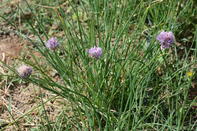
Chives are thought to have originated in Asia and Eastern Europe. Today chives are cultivated worldwide.
Scientific name: Allium schoenoprasum
Common Name: Chives
Plant Description
The chive is related to the onion and has similar leaves to onions but finer. The leaves are cylindrical, hollow and are tapered to the tips. The plant can grow to about 50 cm and has pale purple flowers.
Uses
Chives are used in cooking as well as raw in salads. Chives can also be infused in an oil for flavour.
Soil Requirements and Preparation
Chives grow best in organic, rich sandy loam soils that drain well. The pH of the soil should be between 6 and 7.
Before any soil preparation is done, a representative sample of the soil should be taken and sent to a laboratory for analysis and nutrient recommendations. Soils should be loosened the soil profile to about 500 mm. The lime for pH rectifying and the manure or compost should be applied and ploughed into the top 400 mm of soil about four to five weeks before planting. In the final days before planting, add trace elements and a balanced pre-plant fertilizer to the soil and disc harrow or rotavator into the top 20 cm of soil. This clears any weeds that may have established. Ridging is done at this stage and the seedbeds are prepared for planting. If planting seedlings, plastic mulching can be laid before planting in order to control weeds overgrowing the young plants.
Climate
Chives grow best in cooler climates and thrive best in temperatures of between 18°C and 28°C. Chives are frost resistant, however, growth is slow when the temperatures drop too low.
Cultivars
The common chive is the most popular. There are new cultivar selections that are yielding higher production of leaves. A Finnish variety called "Hankoniemi", a Dutch variety called "Tavallinen" and a German cultivar called 'Grolau' are some of the higher yielding varieties.